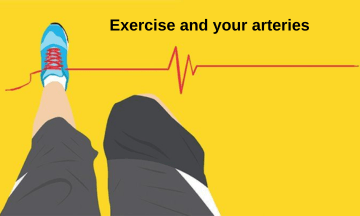Exercise and your arteries

Many years ago, the great English physician Thomas Sydenham concluded, “A man is as old as his arteries.” More than 300 years later and this still holds true since these blood vessels carry vital oxygen-rich blood to all your body’s tissues.
Today we also know how important regular exercise is to maintain artery health.
Your arteries
A regular exercise program works a long way for health of your arteries. In our battle to keep cardiovascular diseases at bay, arteries are at the front line of the battle.
Every artery has three layers in its wall (see figure below). The inner layer, or intima, is composed of a thin layer of endothelial cells that are in direct contact with the bloodstream. The middle layer, or media, is composed chiefly of smooth muscle cells and elastic fibres. The outermost layer, or adventitia, is made up of supporting tissues that are dense and strong in larger arteries but nearly absent in the delicate blood vessels of the brain.

Movement means artery health improvement
Exercising muscles need more blood. And in response to regular exercise, they actually grow more blood vessels by expanding the network of capillaries. In turn, muscle cells boost levels of the enzymes that allow them to use oxygen to generate energy. More oxygen-rich blood and more efficient metabolism: It’s the formula that explains why people who exercise regularly are able to improve their endurance and strength.
It has been observed that health of arteries declines with age. In people who exercise regularly, age had a much smaller effect; endothelial function still declined over the years, but there was a much smaller and more gradual drop in nitric oxide production. Indeed, exercise helped keep arteries young.
People who are 19–64 years of age should aim to get 150 minutes of moderate aerobic activity each week. Younger children should be physically active as well.
.
A person may choose swimming over another form of exercise for a range of reasons. It gives the body a thorough workout and has many advantages for people of all ages and fitness levels. It increases heart rate without putting stress on the body, improves strength, tones muscle, enhances fitness and helps manage weight.
Swimming does not put excess strain on a person’s joints. So, it is especially helpful in individuals with arthritis or a joint injury, as the buoyancy of water reduces stress on weight bearing joints.
It has been observed in scientific studies that swimmers have a lower all-cause mortality risk than did men who are sedentary, walkers or runners. Swimming can also help lower blood pressure levels.
A few days ago, our vascular surgery team at MS Ramaiah had the honour of meeting a young passionate swimmer Miss Mana Patel, from Ahmedabad, Gujarat. She is professional swimmer, who is the first Indian female to represent India in Tokyo Olympics and has several national and international championship medals under her belt. Like any other journey to success, her journey has not been easy with its highs, lows and health related challenges. India is proud of her and our vascular surgery team at Ms Ramaiah wishes her greater success in all her future endeavours.

HOD & Consultant,
Vascular and Endovascular Surgery

